Spanish nobility
Spanish nobles are persons who possess the legal status of hereditary nobility according to the laws and traditions of the Spanish monarchy and those who hold personal nobility as bestowed by one of the three highest orders of knighthood of the Kingdom, namely the Order of the Golden Fleece, the Order of Charles III and the Order of Isabella the Catholic. A system of titles and honours of Spain and of the former kingdoms that constitute it comprise the Spanish nobility. Some nobles possess various titles that may be inherited, but the creation and recognition of titles is legally a prerogative of the King of Spain.

Some noble titles and families still exist which have transmitted that status since time immemorial. Some aristocratic families use the nobiliary particle de before their family name, although this was more prominent before the 20th century. During the rule of Generalísimo Francisco Franco, some new hereditary titles were conceded to individuals, and the titles granted by the Carlist pretenders were officially recognized.
Despite accession to Spain's throne of Juan Carlos I in 1975, the court of nobles holding positions and offices attached to the Royal Household was not restored. Noble titleholders are subjected to taxation, whereas under Spain's ancien régime (until 1923)[1] they were exempt. King Juan Carlos resumed conferral of titles to recognize those whose public service, artistic endeavour, personal achievement, philanthropy, etc., are deemed to have benefitted the Spanish nation.
Spanish nobility today
_02.jpg)
As of 2019, there are approximately 2,237 nobles in Spain and 400 Grandes de España, with 3,200 total titles of Spanish nobility. Some nobles may carry more than one title of nobility. Many are active in the worlds of business, finance, and technology, with some taking on leadership roles in major IBEX 35 companies, some of Spain's largest companies. Examples include the president of FCC, Esther Alcocer Koplowitz, 9th Marchioness of Casa Peñalver, or Alfonso Martínez de Irujo Fitz-James Stuart, Duke of Híjar and Count of Aranda, president of IE Law School in Madrid.[2][3]
Legal situation
In Spain today, the possession of a title of nobility does not imply any legal or fiscal privilege; On the contrary, the possession of titles of nobility is subject to the payment of their corresponding tax. It is a distinction of merely honorary and symbolic character, accompanied by the treatment of the most excellent gentlemen for those titles that possess the dignity of grandees of Spain and of illustrious lords for others. The last privilege, suppressed in 1984, was the right to a diplomatic passport by the grandees of Spain (Grandes de España). This privilege disappeared by Royal Decree 1023/1984. The titles without the rank of grandee of Spain never enjoyed this privilege.
With the establishment of the Second Spanish Republic in 1931, the use of noble titles was abolished by way of Decree of 1 June 1931,[4] ratified by Law of 30 December of the same year.[5] In 1948, legal recognition of the usage of noble titles was provided for by Law of 4 May 1948 restoring the rules as they were before 14 April 1931.[6]
At present, titles of nobility find their legal basis in article 62, section f, of the 1978 constitution, which grants the prerogative of the king to grant honors and distinctions in accordance with the laws.
Spanish legislation recognizes titles of nobility and protects their legal owners against third parties. The Spanish nobility titles are in no case susceptible of purchase or sale, since their succession is strictly reserved for blood relatives of better right of the first holder of the title. The successions are processed by the Ministry of Justice and their use is subject to their respective tax.
Classification of Spanish nobles
.svg.png) The crown of the Spanish monarch
The crown of the Spanish monarch The crown of the Prince or Princess of Asturias (heir apparent)
The crown of the Prince or Princess of Asturias (heir apparent)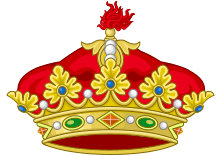 The coronet of an infante (prince)
The coronet of an infante (prince)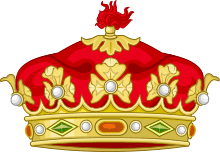 A coronet of a grandee
A coronet of a grandee.svg.png) A coronet of a Spanish duke
A coronet of a Spanish duke.svg.png) A coronet of a Spanish marquess
A coronet of a Spanish marquess A coronet of a Spanish count
A coronet of a Spanish count A coronet of a Spanish viscount
A coronet of a Spanish viscount A coronet of a Spanish baron
A coronet of a Spanish baron A coronet of a Spanish señor (lord)
A coronet of a Spanish señor (lord)
Spanish nobles are classified as either grandees, as titled nobles, or as untitled nobles.
In the past, grandees were divided into first, second, and third classes, but this division has ceased to be relevant in practice while remaining a titular distinction; legally all grandees enjoy the same privileges in modern times. At one time however, each class held special privileges such as:
- those who spoke to the king and received his reply with their heads covered.
- those who addressed the king uncovered, but put on their hats to hear his answer.
- those who awaited the permission of the king before covering themselves.
Additionally, all grandees were addressed by the king as mi Primo (my Cousin), whereas ordinary nobles were only qualified as mi Pariente (my Kinsman).
An individual may hold a grandeeship, whether in possession of a title of nobility or not. Normally, however, each grandeeship is attached to a title. A grandeeship is always attached to the grant of a ducal title. The grant of a grandeeship with any other rank of nobility has always been at the will of the sovereign. Excepting dukes and some very ancient titles of marquesses and counts, most Spanish titles of nobility are not attached to grandeeships.
A grandee of any rank outranks a non-grandee, even if that non-grandee's title is of a higher degree, with the exception of official members of the Spanish Royal Family who may in fact hold no title at all. Thus, a baron-grandee enjoys higher precedence than a marquess who is not a grandee.
Since 1987, the children of Spanish infantes, traditionally considered part of the royal family, have been entitled to the rank and style of a grandee but do not hold the legal dignity of grandee unless a grandeza is officially conferred by the sovereign; once the dignity has been officially bestowed, it becomes hereditary.
Some notable titles, which are attached to grandeeships, are: Duke of Alba, Duke of Medinaceli, Duke of Osuna, Duke of Infantado, Duke of Albuquerque, Duke of Nájera, Duke of Frías and Duke of Medina Sidonia, Marquess of Aguilar de Campoo, Marquess of Astorga, Marquess of Santillana, Marquess of Los Vélez, Count of Benavente, Count of Lerín, Count of Olivares, Count of Oñate, and Count of Lemos.
Form of address
Dukes, Grandees, their spouses and heirs are entitled to the honorific style of The Most Excellent Lord/Lady.
Titled nobles without a Grandee, their spouses and offspring use the style of The Most Illustrious Lord/Lady.
Ranks
The ordinary Spanish nobility is divided into six ranks. From highest to lowest, these are: Duque (Duke), Marqués (Marquess), Conde (Count), Vizconde (Viscount), Barón (Baron), and Señor (Lord) (as well as the feminine forms of these titles).
Nobility descends from the first man of a family who was raised to the nobility (or recognized as belonging to the hereditary nobility) to all his legitimate descendants, male and female, in the male line. Thus, most persons who are legally noble, hold no noble title. Hereditary titles formerly descended by male-preference primogeniture, a woman being eligible to inherit only if she had no brother or if her brothers also inherited titles. However, by Spanish law, all hereditary titles descend by absolute primogeniture, gender no longer being a criterion for preference in inheritance, since 2005.
Princes

The often overlooked title of 'prince' (príncipe/princesa) has historically been borne by those who have been granted or have inherited that title. It is often not included in lists of the Spanish nobility because it is rare. Prince/Princess are English translations of Infante/Infanta, referring to the son or daughter of a king; such titles are reserved for members of the royal family (the heir to the throne or the consort of the Queen regnant). Historically, infante or infanta could refer to offspring, siblings, uncles and aunts of a king. The heir's princely titles derive from the ancient kingdoms which united to form Spain.
Three titles of prince are held by the heir to the Spanish throne.
- Prince of Asturias as heir apparent to the throne of the Kingdom of Castile and León.
- Prince of Girona as heir apparent to the throne of the Kingdom of Aragon.
- Prince of Viana as heir apparent to the throne of the Kingdom of Navarre.
Other titles of 'prince' were frequently granted by the kings of Spain, but usually in their capacity as kings of Naples or of Sicily. Such nobles often sojourned at the Spanish court where their titles were acknowledged, but rarely were Spanish nobles the recipients of a title of prince in Spain. The most notable exceptions were the title Prince of the Peace conferred in 1795 on Manuel Godoy, a favourite of the Spanish king and the title Prince of Vergara conferred to Baldomero Espartero. Although legislation of the twentieth century ended official recognition of the title of prince outside the royal bloodline family, it did allow the holder of a princedom to have the dignity converted to a ducal title of the same name.
Duke/Duchess (Duque/Duquesa)

All dukedoms are attached to a grandeeship. A partial list includes:
- Duke of Abrantes
- Duke of Acerenza
- Duke of Ahumada
- Duke of Alagón
- Duke of Alba
- Duke of Alburquerque
- Duke of Alcalá de los Gazules
- Duke of Alcudia
- Duke of Algeciras
- Duke of Algete
- Duke of Aliaga
- Duke of Almazán
- Duke of Almazán de Saint Priest
- Duke of Almenara Alta
- Duke of Almodóvar del Campo
- Duke of Almodóvar del Río
- Duke of Almodóvar del Valle
- Duke of Amalfi
- Duke of Andria
- Duke of Ansola
- Duke of Arco
- Duke of Arcos
- Duke of Arevalo del Rey
- Duke of Arion
- Duke of Arjona
- Duke of Atrisco
- Duke of Aveiro
- Duke of Badajoz
- Duke of Baena
- Duke of Bailén
- Duke of Baños
- Duke of Béjar
- Duke of Benavente
- Duke of Bivona
- Duke of Cádiz
- Duke of Camiña
- Duke of Canalejas
- Duke of Cánovas del Castillo
- Duke of Cardona
- Duke of Ciudad Rodrigo, bestowed on the 1st Duke of Wellington for his services to the Spanish King
- Duke of Feria
- Duke of Fernández-Miranda
- Duke of Franco, bestowed upon the descendants of General Francisco Franco
- Duke of Gandia
- Duke of Infantado
- Duke of Lugo
- Duke of Medina Sidonia
- Duke of Medinaceli
- Duke of Moctezuma de Tultengo, held by the descendants of the Aztec Emperor Moctezuma II
- Duke of Mola, held by the descendants of Emilio Mola, a leader of the 1936 military putsch
- Duke of Najera
- Duke of Osuna
- Duke of Palma de Mallorca
- Duke of Primo de Rivera
- Duke of Ripperda
- Duke of Segovia
- Duke of Seville
- Duke of Sotomayor
- Duke of Suárez
- Duke of Tetuan
- Duke of Veragua, held by the descendants of Christopher Columbus
- Duke of the Victory
Marquess/Marchioness (Marqués/Marquesa)


- Marquess of Aguilar de Campoo
- Marquess of Albudeyte
- Marquess of La Algaba
- Marquess of Almazán
- Marquess of Altamira
- Marquess of Arcicóllar
- Marquess of Ardales
- Marquess of Arellano
- Marquess of Astorga
- Marquess de Barbará
- Marquess of Benidoleig
- Marquess de la Cadena
- Marquess of Camarasa
- Marquess of Camarines
- Marquess of Campotéjar
- Marquess of Cañada Honda
- Marquess de la Candia
- Marquess of Cañete
- Marquess of Casa Fuerte
- Marquess of Chinchilla
- Marquess of Cortes de Aragón
- Marquess of Del Bosque
- Marquess of Figueroa
- Marquess of Frigiliana
- Marquess of Fuente el Sol
- Marquess of Galatone
- Marquess of Guadalest
- Marquess of Iria Flavia
- Marquess of Irujo y los Arcos
- Marquess of Isla de Arousa
- Marquess de los Jardines de Aranjuez
- Marquess of Leganés
- Marquess of Mariño
- Marquess of Menendez
- Marquess of Montsalud
- Marquess of Morella
- Marquess of Navamorcuende
- Marquess of Novaliches
- Marquess of Olías[7]
- Marquess of Prado Ameno
- Marquess of Ría de Ribadeo
- Marquess of Las Salinas
- Marquess of Salobreña
- Marquess of Samaranch
- Marquess of San Lorenzo de Valleumbroso
- Marquess of Santa Maria de Silvela
- Marquess of San Saturnino
- Marquess of Santillana
- Marquess de Sierra de Outes
- Marquess of Sierra Nevada
- Marquess of Tabuerniga
- Marquess of Valdecarzana
- Marquess of Vallado
- Marquess of Vargas Llosa
- Marquess of Villaverde
- Marquess of Villena
Count/Countess (Conde/Condesa)
- County of Aguilar de Inestrillas
- County of Albay
- County of Aviles
- County of Barcelona held by Don Juan, heir of Alfonso XIII, father of Juan Carlos I
- County of Batanes
- County of Candia de Valencia
- County of Casa Bayona
- County of Castille de Vigo
- County of Cervera
- County of Covadonga
- County of Elda: belonged to the House of Coloma.
- County of Empúries
- County of Estrada
- County of Fontao
- County of Fuensaldaña
- County of Frigiliana
- County of Guadalupe del Peñasco
- County of Guaqui
- County of Jolo
- County of Lacambra
- County of Lucena
- County of Luchana
- County of Manila
- County of Mansilla
- County of Molins
- County of Montealegre
- County of Olivito
- County of Olocau
- County of Peñaranda de Bracamonte
- County of Ripalda
- County of Roussillon
- County of Ruiz de Castilla
- County of Salvatierra
- County of Siles-Villegas
- County of Soria
- County of Teba
- County of Toreno
- County of Urgell
- County of Vigo
Viscount/Viscountess (Vizconde/Vizcondesa)
- Viscountcy of la Alborada
- Viscountcy of Altamira
- Viscountcy of Banderas
- Viscountcy of Cabrera
- Viscountcy of la Calzada
- Viscountcy of Castillo de Almansa
- Viscountcy of Jala-Jala
- Viscountcy of Mindanao
- Viscountcy of Quintanilla de Florez
- Viscountcy of Rocabertí
Baron/Baroness (Barón/Baronesa)
Baronies did not exist in the Kingdom of Castile nor the Kingdom of Navarre, and the subsequent kings of Spain did not confer any baronies attached to Castilian or Navarrese estates. However, they did exist in the Kingdom of Aragon, such as:
- Baron of Polop
Lord/Lady (Señor/Señora) (Don/Doña)
The title of Señor is, together with that of Conde, the oldest in seniority of the Spanish realms. Many of these lordships are among the oldest titles of nobility in Spain, and the Señor usually exercised military and administrative powers over the lordship. Although some lordships were created by the kings of Spain, others existed before them and have not been created by any known king. For example, the Señor of Biscay held a great degree of independence from the king of Castile, to whom he could pledge or not pledge feudal allegiance, but of whom he was not automatically a vassal: each new lord of Biscay had to renew his oath to the king. Ultimately however, the kings of Castile inherited the lordship.
Besides those held by the King, in Spain remain seven lordships that maintain the official consideration of Titles of the Kingdom according to the Official Guide of the Titles and Grandees of the Kingdom published by the Ministry of Justice: the Lordship of Solar de Tejada, the Lordship of Solar de Mandayona y Villaseca, the Lordship of Alconchel, the Lordship of Lazcano (with Grandee of Spain), the Lordship of Rubianes (with Grandee of Spain), the Lordship of Higuera de Vargas (with Grandee of Spain), the Lordship of Meirás (with Grandee of Spain) and the Lordship of Sonseca. Other lordships that were considered as Titles of the Kingdom in the past, have not been rehabilitated.
- Lord of Alconchel
- Lord of Balaguer, held by the King of Spain
- Lord of Benafarces y Lobones
- Lord of Biscay, held by the Spanish monarchy since 1378, when merged with the previously semi-independent lordship of Biscay
- Lord of Cameros
- Lord of Higuera de Vargas
- Lord of Casa Lazcano
- Lord of Lecubarri, held by the descendants of the Dukes of Gascony
- Lord of Llafranc
- Lord of Marcoartu
- Lord of Meirás, señora de Meiras, Carmen Polo wife of Francisco Franco
- Lord of Molina de Aragón, held by the King of Spain
- Lord of Montalbo
- Lord of Casa Rubianes
- Lord of San Roque
- Lord of Señorío of Mandayona y Villaseca
- Lord of Solar de Tejada
- Lord of Sonseca
Other titles
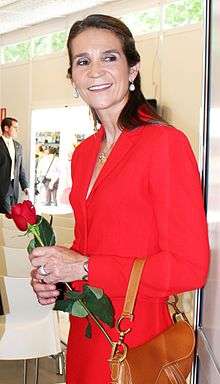
- Infante: currently borne by royal princes, other than the heir apparent to the throne, who are sons of a Spanish king.
- Knight of the Order of Charles III caballero de la Orden de Carlos III: the bestowal of the highest order of knighthood on an individual grants personal nobility and certain heraldic privileges such as a heraldic mantle. The King of Spain continues to bestow this honor.
- Knight of the Royal Order of Isabella the Catholic caballero de la Orden de Isabel la Catolica: the bestowal of the second highest order of knighthood on an individual grants personal nobility and certain heraldic privileges such as a golden heraldic mantle. The King of Spain continues to bestow this honor.
- Ricohombre (fem. Ricahembra): used during the Reconquista. By the 17th century, it was a synonym of nobleman.
- Condestable: cognate with "constable", it was a hereditary title used in the kingdoms of Castile and León for the official second in authority to the king. It became hereditary in the Velasco family which, however, gradually lost the powers once attributed to the Condestable of Castile.
- Caballero: equivalent to knight, it was very rare in the kingdom of Castile, but common in the kingdom of Aragon, where there were four types of caballeros:
- Golden-spur caballero: borne by those infanzones (descendants of one of the cadet branches of the kings of Aragon which did not inherit the throne) who had been knighted. They were the highest ranking knights.
- Royal-privilege caballero: a personal, non-hereditary title granted by the king to doctors of the law. It was rarely used by its holders, since the doctoral status enjoyed more privileges.
- Caballero Mesnadero: borne by the cadet sons of a Ricohombre. It fell into desuetude during the 18th century, when the Bourbon kings purged the ranks of the nobility.
- Caballero franco: borne by those of hijosdalgo or infanzone status, but who were commoner-born.
- Potestad: borne only in the kingdom of Aragon, the equivalent of the Italian podestà, an administrative title. It disappeared with the Nueva Planta decrees in 1713.
Lower nobility
Lower nobility held ranks, without individual titles, such as infanzon (in Aragon, e.g. Latas Family), hidalgo or escudero. These did not, however, correspond to the status of a baron, a title unknown to Spanish nobility except in Catalonia.
Hidalgo was the most common of these: Originally all the nobles in the Western Peninsular Christian Realms were hidalgos and, as cristianos viejos, held nearly exclusive right to privileged status (although there were some Jews and Muslims recognized as hidalgos, who shared their privilege to bear arms as knights in the mesnada real). The first of the kings of Pamplona and Asturias were originally elected and lifted up on a shield to assume Princeps inter Pares status, by these otherwise untitled nobles. For approximately three hundred years the hidalgos retained this privilege, only a few of them eventually being granted the non-heritable title of Comes#Medieval usages. Unlike Spain's later titled nobles, the early hidalgo did not necessarily possess or receive any fief or land grant. Many were as poor as commoners, although they were tax-exempt and could join the civil service or the army.
During the Middle Ages hidalgo became a title granted by the kings of Castile as a reward for service done to the crown (or, as in Biscay, as a way of recognizing prior rights). In the same way escudero was granted for military achievement when the Reconquista ended. Being the most obvious proof of noble descent, hidalgo came to be the only lesser title to remain among the modern ranks of Spanish nobility. From this ancient estate of the realm emerged Spain's nobility. All titled and untitled nobles are considered hidalgos, but many of the modern titled nobility do not descend from the original hidalguía.
The term Hidalgo de Sangre indicated membership in a family whose noble status was recognized in the earliest records of its existence; thus its immemorial nobility was acknowledged but not created by any monarch.
Succession
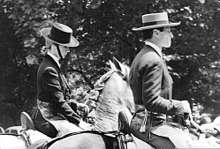
The evidence supporting one's claim to a title may be reviewed by the Deputation of Grandees and Titled Nobles of the Kingdom (Diputación de Grandes y Títulos del Reino). The body includes eight grandees, eight nobles who are not grandees, and a president who must hold both a grandeeship and a hereditary title unattached to a grandeeship.
Succession to Spanish noble titles is hereditary, but not automatic. The original letters patent which created the title determine the order of succession. Payment of substantial fees is required whenever a title is inherited.
While noble titles historically have followed the rule of male-preference primogeniture, a Spanish law came into effect on October 30, 2006, after approval by both houses of the Cortes, establishing the inheritance of hereditary noble titles by the firstborn regardless of gender. The law is retroactive to July 27, 2005.[9]
Following the death of a noble, the senior heir may petition the sovereign through the Spanish Ministry of Justice for permission to use the title. If the senior heir does not make a petition within two years, then other potential heirs may do so on their own behalf. There is a limit of forty years from the vacancy by death or relinquishment of a title within which that title may be claimed and revived by an heir.
The petitioner must demonstrate that he or she is a child, grandchild or direct male line descendant of a noble (whether a grandee or not), or that he or she belongs to certain bodies or orders of chivalry deemed noble, or that the father's family is recognized as noble. The amount of fees due depend on whether the title is attached to a grandeeship or not, and on whether the heir is a direct descendant or a collateral kinsman of the previous holder. The petition is normally granted, except if the petitioner is a criminal.
Titles may also be ceded to heirs other than the senior heir, during the lifetime of the main titleholder. Normally, this process is used to allow younger children to succeed to lesser titles, while the highest or principal title goes to the senior heir. Only subsidiary titles may be ceded; the principal title must be reserved for the senior heir. The cession of titles may only be done with the approval of the monarch.
The late Cayetana Fitz-James Stuart, 18th Duchess of Alba (1926–2014) holds the Guinness World Record for number of titles with over 50 titles. Before her death, she ceded some of her titles to each of her six children; otherwise, all but the eldest would have been excluded from succession.
Titles created during the reign of King Juan Carlos
From the beginning of his reign in November 1975, King Juan Carlos created new titles for about 51 people (as of April 2011),[10] among others recognizing the merits of politicians and artists. Some of these dignities have been hereditary. Examples include:
- Carmen Franco y Polo, daughter of dictator Francisco Franco, created 1st Duchess of Franco and Grandee of Spain in 1975
- Carlos Arias Navarro, Prime Minister, created 1st Marquess of Arias Navarro and Grandee of Spain in 1976
- Torcuato Fernández-Miranda y Hevia, Prime Minister, created 1st Duke of Fernandez-Miranda and Grandee of Spain in 1977
- Adolfo Suárez, Prime Minister, created 1st Duke of Suárez and Grandee of Spain in 1981
- Andrés Segovia, classical guitarist, created 1st Marquess of Salobreña in 1981
- Salvador Dalí, surrealist painter, created 1st Marquess of Dalí de Púbol in 1982
- Joaquín Rodrigo, composer and pianist, created 1st Marquess of los Jardines de Aranjuez in 1991
- Juan Antonio Samaranch, President of the International Olympic Committee, created 1st Marquess of Samaranch and Grandee of Spain in 1991
- Manuel Gutiérrez Mellado, officer and politician, created 1st Marquess of Gutiérrez-Mellado in 1994
- Camilo José Cela, author and Nobel laureate, created 1st Marquess of Iria Flavia in 1996
- Leopoldo Calvo-Sotelo, Prime Minister, created 1st Marquess of the Ría of Ribadeo and Grandee of Spain in 2002
- Margarita Salas, scientist, created 1st Marchioness of Canero in 2008
- Paloma O'Shea Artiñano, pianist, created Marchioness of O'Shea in 2008
- José Ángel Sánchez Asiaín, an international banker, created 1st Marquess of Asiaín in 2010
- Antoni Tàpies, painter, created 1st Marquess of Tàpies in 2010
- Vicente del Bosque, football manager, created 1st Marquess of Del Bosque in 2011
- Mario Vargas Llosa, author and Nobel laureate, created 1st Marquess of Vargas Llosa in 2011.
King Juan Carlos also exceptionally confirmed the title of Count of Barcelona, a title historically attached to the Crown, but used as a title of pretence by his father, Infante Juan, during the dynasty's 20th century exile and the subsequent reign of his son.
Gallery
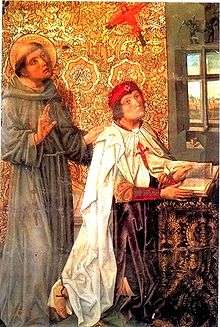 Álvaro de Luna, Duke of Trujillo (1390–1453)
Álvaro de Luna, Duke of Trujillo (1390–1453)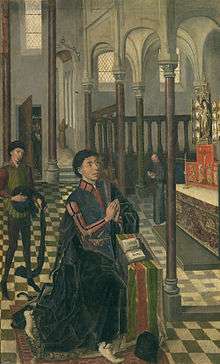
.jpg)
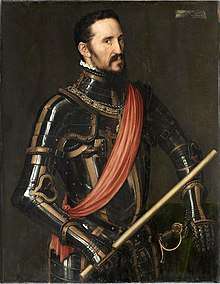 Fernando Álvarez de Toledo, 3rd Duke of Alba (1507–1582)
Fernando Álvarez de Toledo, 3rd Duke of Alba (1507–1582) Gabriel de la Cueva, 5th Duke of Alburquerque (1515–1571)
Gabriel de la Cueva, 5th Duke of Alburquerque (1515–1571)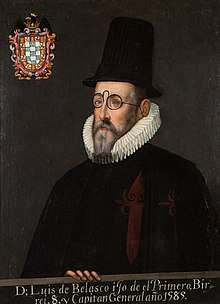 Luis de Velasco, Marquess of Salinas (1534–1617)
Luis de Velasco, Marquess of Salinas (1534–1617)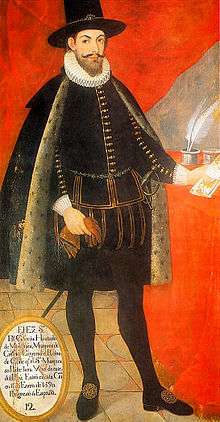 García Hurtado de Mendoza, 5h Marquess of Cañete (1535–1609)
García Hurtado de Mendoza, 5h Marquess of Cañete (1535–1609)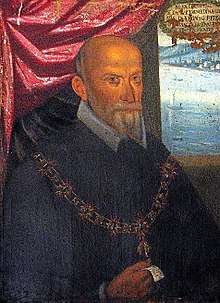 Alonso Pérez de Guzmán, 7th Duke of Medina Sidonia (1550–1615)
Alonso Pérez de Guzmán, 7th Duke of Medina Sidonia (1550–1615) Juan Alonso Pimentel de Herrera, 5th Duke of Benavente (c. 1550 – 1621)
Juan Alonso Pimentel de Herrera, 5th Duke of Benavente (c. 1550 – 1621).jpg) Francisco Gómez de Sandoval, 1st Duke of Lerma (1552–1625)
Francisco Gómez de Sandoval, 1st Duke of Lerma (1552–1625).jpg) Ambrogio Spínola, 1st Marquess of Balbases (1569–1630)
Ambrogio Spínola, 1st Marquess of Balbases (1569–1630).png) Álvaro de Bazán, 2nd Marquess of Santa Cruz (1571–1646)
Álvaro de Bazán, 2nd Marquess of Santa Cruz (1571–1646) Pedro Téllez-Girón, 3rd Duke of Osuna (1574–1624)
Pedro Téllez-Girón, 3rd Duke of Osuna (1574–1624)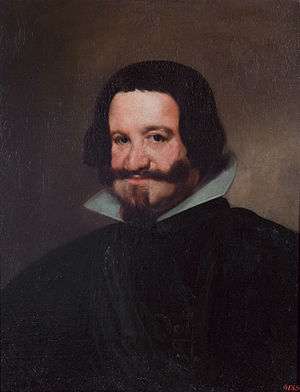 Gaspar de Guzmán, Count-Duke of Olivares (1587–1645)
Gaspar de Guzmán, Count-Duke of Olivares (1587–1645) Diego López Pacheco, 7th Duke of Escalona (1599–1653)
Diego López Pacheco, 7th Duke of Escalona (1599–1653) Luis de Benavides Carrillo, Marquess of Caracena (1608–1668)
Luis de Benavides Carrillo, Marquess of Caracena (1608–1668)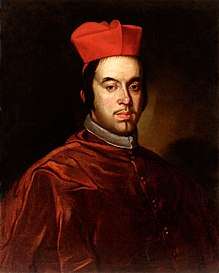 Cardinal Luis Manuel Fernández de Portocarrero (1635–1709)
Cardinal Luis Manuel Fernández de Portocarrero (1635–1709)- Íñigo Melchor de Velasco, 7th Duke of Frías (1635–1696)
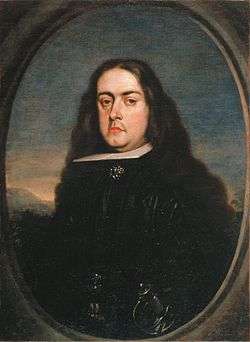
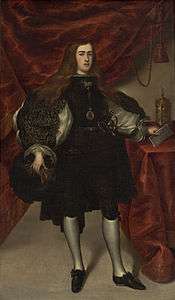
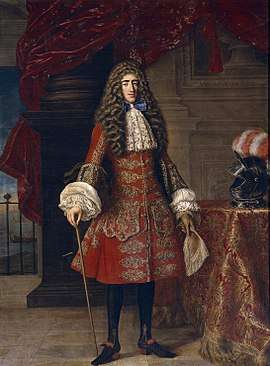 Luis Francisco de la Cerda, 9th Duke of Medinaceli (1660–1711)
Luis Francisco de la Cerda, 9th Duke of Medinaceli (1660–1711)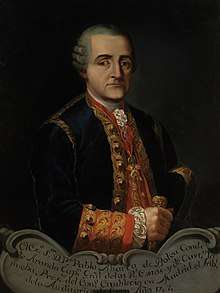
 José Moñino, 1st Count of Floridablanca (1728–1808)
José Moñino, 1st Count of Floridablanca (1728–1808)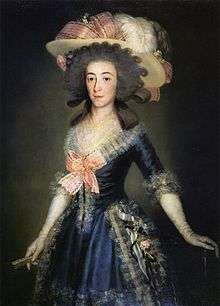 María Josefa Pimentel, Duchess of Osuna (1752–1834)
María Josefa Pimentel, Duchess of Osuna (1752–1834) María Cayetana de Silva, 13th Duchess of Alba (1762-1802)
María Cayetana de Silva, 13th Duchess of Alba (1762-1802).jpg) Don Pedro de Alcántara Álvarez de Toledo, 13th Duke of the Infantado (1768–1841)
Don Pedro de Alcántara Álvarez de Toledo, 13th Duke of the Infantado (1768–1841) Miguel Ricardo de Álava (1770-1843)
Miguel Ricardo de Álava (1770-1843)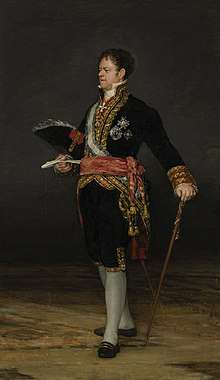
.jpg) José Rafael de Silva Fernández de Híjar, 12th Duke of Híjar (1776-1863)
José Rafael de Silva Fernández de Híjar, 12th Duke of Híjar (1776-1863).jpg) José María Queipo de Llano, 7th Count of Toreno (1786-1843)
José María Queipo de Llano, 7th Count of Toreno (1786-1843)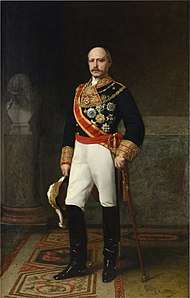 Francisco Serrano, 1st Duke of la Torre (1810-1885)
Francisco Serrano, 1st Duke of la Torre (1810-1885)- Ángel de Saavedra, 3rd Duke of Rivas (1815–1854)
See also
- Immemorial nobility
Notes
- "The Agony of Spanish Liberalism: From Revolution to Dictatorship 1913–23". Francisco J. Romero Romero Salvadó, A. Smith. Retrieved 24 November 2016. ISBN 978-1-349-36383-4.
- https://elpais.com/economia/2019/09/19/actualidad/1568884329_726800.html
- https://www.20minutos.es/noticia/2304533/0/titulos-nobiliarios/tipos-jerarquia/privilegios/
- https://www.boe.es/datos/pdfs/BOE//1931/153/A01122-01123.pdf
- https://boe.es/datos/pdfs/BOE//1932/008/A00210-00211.pdf
- https://www.boe.es/buscar/act.php?id=BOE-A-1948-3512
- Antonio Luque García (2005). Grandezas de España y títulos nobiliarios (in Spanish). Ministerio de Justicia. p. 258. ISBN 978-84-7787-825-4. Retrieved 9 April 2017.
- https://elpais.com/elpais/2014/11/20/inenglish/1416479431_740499.html
- "Ley 33/2006, de 30 de octubre, sobre igualdad del hombre y la mujer en el orden de sucesión de los títulos nobiliarios" (in Spanish). Boletin Oficial del Estado. Retrieved 10 January 2016.
- "Nobiliario Español" : Titles and Grandeeships conferred by Juan Carlos I., with actual holders.
References
- Atienza, Julio de. Nobiliario Español: Diccionario Heráldico de Apellidos Españoles y de Títulos Nobiliarios. Madrid: Aguilar, 1948.
- Figueroa y Melgar, Alfonso de. Estudio Histórico Sobre Algunas Familias Españolas. 6v. in 12 parts. Madrid: Editions Dawson & Fry, 1965.
- Noble Titles in Spain and Spanish Grandees
- Nobility & Grandee Titles in Spain (Ministry of Justice)

